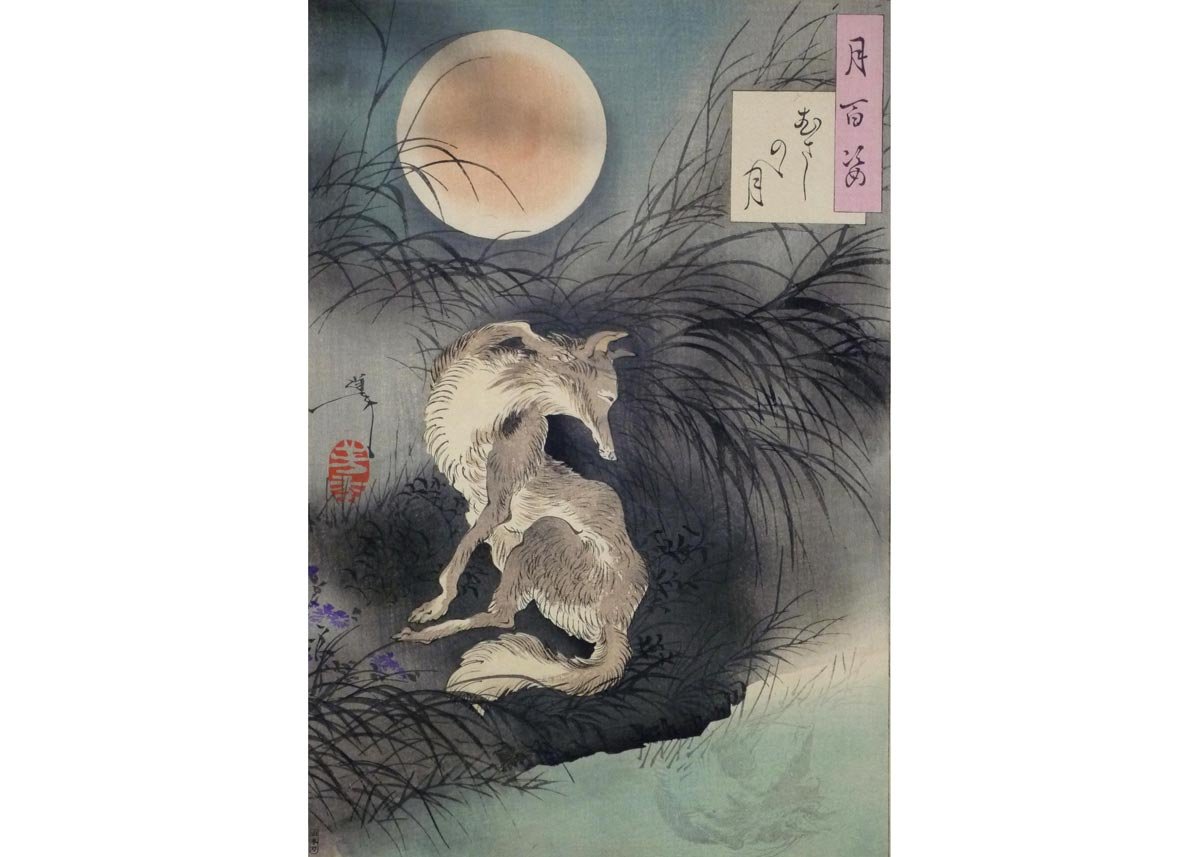6 Things to Know About the Inari Fox in Japanese Folklore
by David McElhinney | ART
Japanese folklore and religious mythology is rife with anthropomorphic and deified creatures, from the huge-testicled tanuki (raccoon dogs) to the three-legged crow which remains a symbol of the nation.
The kitsune (fox) recurs throughout stories in Japanese history, usually appearing as an intelligent and/or cunning being with paranormal abilities and often residing at Shinto shrines. They’re portrayed as having a deep connection with their human companions and as manifestations of a major kami (Shinto spirt) in the Japanese story of creation.
But this only hints at the enduring importance of the kitsune in Japan. So, if you want to find out more, read on for everything you need to know about kitsune in Japanese culture.
1. Why are Kitsune Foxes Popular in Japanese culture?
The Moon of Musashino by Tsukioka Yoshitoshi, around 1890
Kitsune have been a part of Japanese religious culture for as long as the culture has existed in any meaningful sense. Long before Japan came under imperial rule, it was populated by nomadic tribes whose spirit worlds were fueled by deeply held polytheistic animist beliefs. (It wasn’t until the arrival of Chinese Buddhists and Confucians in the 6th century AD that these beliefs would be collectively termed Shintoism.)
To these nomads, the entire natural world, both animate and inanimate, alive or dead, was imbued with spirits. And the fox, a creature native to the archipelago and in abundance in prehistoric Japan’s dense forests, slowly began to take on a mystical significance.
By at least the 8th century, and likely even earlier, shrines were dedicated to kitsune, or more precisely, the fox incarnations of the Shinto kami, Inari – the goddess of rice, harvests, agriculture, fertility and more. Inari was said to have arrived in Japan during its creation riding on the back of a white fox. A harsh famine had struck the land, ushering the goddess from her heavenly abode into the land of mankind carrying grains to liberate the starving people from their hunger.
In 711 AD, the first Inari shrine was erected on the eponymous Inari Mountain in Kyoto to solidify the significance of the myth. Kitsune would operate as the guardian protectors of the shrine, and their physical presence throughout the nation would forever be a reminder of the benevolent goddess’s deeds.
2. What do Kitsune Represent?
The concept of god is pretty flexible in Japan, and so too are the representations of the kitsune. In their Inari form, kitsune symbolize good harvests, tea and sake, fertility and prosperity, cunning and smarts, business and money, all in equal measures and all at different turns.
The Shinto pantheon is believed to be infinite, but Inari is certainly one of the most important spirits, thus making kitsune among the most important of creatures. The most common depiction of foxes is at Inari shrines, 32,000 of which exist across Japan, making up over 30% of the total number of shrines of any kind.
© Nandin Yuan, Inari Fox
A pair of stone kitsune usually appear at Inari shrine gates or in the form of sculptures within shrine complexes. They are there to protect both the spirit world and the worshippers within. As such, visitors will leave votive offerings to the foxes, often in the form of tofu (supposedly their favorite food).
This stunning image is from photographer Nandin Yuan. You can check out his work at Studio Bridge.
3. What are Some Common Manifestations of the Kitsune in Japanese Folklore?
The Fox Demon, Woodblock Print by Gekko Ogata, 1893
There are said to be 13 different types of mythical kitsune, each corresponding to an “element”: Celestial, Darkness, Wind, Spirit, Fire, Earth, River, Ocean, Mountain, Forest, Thunder, Time and Sound. But more commonly, they are divided into two diametrically opposed camps: nogitsune (bad) and zenko (good), representing the duality and balance of life on earth.
Whether a given kitsune augurs good or ill, however, depends on the circumstance on which it’s encountered. In yokai (ghost story) folklore, kitsune evolve greater abilities as they age. Natural shapeshifters, they are believed to be able to take human form after they have reached their hundredth year.
Abe no Yasunari Revealing the Nine-Tailed Fox, by Toyokuni III, 1842
Evil foxes, known as nogitsune, are wild creatures that serve no god and carry no divinity within their souls. They are known for shifting into human form, and in some cases presenting themselves as beautiful women to lure powerful men into their traps. They are also guilty of kitsunetsuki, possessing the spirts of young girls, to feed on their life force as well as for their own sadistic amusement.
Fox and Tanuki Netsuke by Sukenaga, early 19th Century, V&A Museum
Benevolent kitsune, also called zenko, are the messengers and reincarnations of souls in the spirit world, often growing new tails as they become more powerful. Once they reach a total of nine their fur turns white or gold and they begin to acquire powerful abilities beyond comprehension, including the bending of time and space. Nine-tailed kitsune are said to have heightened perceptions, can hear and see all that happens in the world, and eventually attain omniscience.
4. What are some Famous Kitsune in Literature?
One of the most famous examples of kitsune in pop culture is through the Pokémon Vulpix (a fire kitsune) and its evolved form, Ninetails. In later editions of the game, Alolan Vulpix (an ice kitsune) and its subsequent evolution Alolan Ninetails would also be introduced. Particularly in their evolved forms, these Pokémon gained mysterious powers, staying true to the mythological source material.
Kitsune are also heavily represented in campfire stories, such as The Grateful Foxes, The Fox and the Tanuki (later adapted into a manga series), the Foxes’ Wedding and How Tokutaro Was Deluded by Foxes, all of which have been told for generations. In Christopher Kincaid’s introductory primer Come and Sleep, the author details the rich history of this tradition with authority and wit.
5. What are some Famous Kitsune in Art?
Inro with Fox's Wedding, late 18th Century, Met Museum
Kitsune were often depicted on inro, intricate hardcase pouches hung from the belt of a pocketless kimono. The above inro dates back to the Edo era, evidencing the rich tradition of kitsune in Japanese iconography. The depicted kitsune are linked to the shrine in the background. Note the fox whose tail is being revealed: the kitsune’s tail had real symbolic significance, and often foxes had difficulty hiding these when in human form.
© Kansetsu Hashimoto, Summer Evening, 1941, Adachi Museum of Art
Kitsune were frequently represented in paintings and ukiyo-e woodblock prints. The artist Kansetsu Hashimoto was renowned for his elegant paintings of Japanese wildlife. In Hashimoto’s calming nihonga-style Inari fox painting, he focuses less on the kistune’s religious significance, rather celebrating it for its elegant natural form.
The Fox-Woman Kuzunoha by Tsukioka Yoshitoshi, 1890
Tsukioka Yoshitoshi (1839 -1892), one of the last great ukiyo-e masters, also celebrated the fox in his works. In his 100 Aspects of the Moon series he portrays a kitsune creeping through moonlit fields garbed in women’s clothing, hinting at foxes’ more mischievous incarnations.
6. Where Can You See Kitsune in Japan?
Fushimi Inari Taisha is one of the most famous shrines in the nation, famed for its procession of red torii gates snaking through hillsides. But it’s also the birthplace of fox shrines in Japan, and in commemoration of this, stone kitsune are peppered throughout the complex, guarding gates and watching over worshippers.
At Toyokawa Inari Shrine in Aichi Prefecture, Shinto and Buddhist symbolism exist in harmony. There are also thousands of miniature stone foxes congregated in the grounds. Many of the foxes wear red bibs as a sign of their divinity or hold scrolls in their mouth symbolizing their roles as messengers of the gods.
Takayama Inari Shrine in Aomori Prefecture is a smaller and considerably less crowded version of its Kyoto counterpart, Fushimi Inari Taisha. A procession of grand stone foxes marks the trail to the torii gates.
If you want to see kitsune in the flesh, head to Zao Fox Village in Miyagi Prefecture. Over 100 foxes, and several different species, roam the reserve, which visitors can enter. A shrine is located in the village as are platforms from which you can buy food to feed the foxes, while in spring there are also opportunities to hold newborn baby foxes.
February 5, 2022 | Art, Craft, Prints, Painting, Photography
JO SELECTS offers helpful suggestions, and genuine recommendations for high-quality, authentic Japanese art & design. We know how difficult it is to search for Japanese artists, artisans and designers on the vast internet, so we came up with this lifestyle guide to highlight the most inspiring Japanese artworks and designs for your everyday needs.
All product suggestions are independently selected and individually reviewed. We try our best to update information, but all prices and availability are subject to change. Japan Objects is a member of the Amazon affiliates program and if you buy something through our links, Japan Objects may earn an affiliate commission at no cost to you.


















ART | October 6, 2023